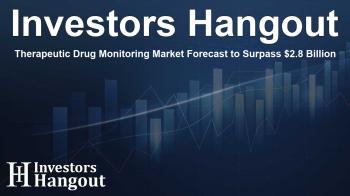Therapeutic Drug Monitoring Market Forecast to Surpass $2.8 Billion

Overview of the Therapeutic Drug Monitoring Market
The global therapeutic drug monitoring (TDM) market has shown substantial growth and is anticipated to expand from USD 1.92 billion in 2024, reaching approximately USD 2.8 billion by 2034. This promising trajectory includes a compound annual growth rate (CAGR) of 3.84%, reflecting the increasing importance of precision in medicine and drug administration.
Growth Drivers Behind TDM Market Expansion
Several factors contribute to the growth of the TDM market. The escalation of various diseases, alongside advancements in diagnostic applications, is boosting the need for tailored therapeutic solutions. Furthermore, the shift towards precision medicine—where therapies are customized based on patients' specific responses—is significantly propelling market demand. This is particularly relevant for drugs that require careful monitoring to ensure safety and effectiveness.
Rising Demand for Personalized Medicine
A key driver is the increasing demand for personalized medicine, enabling healthcare providers to prescribe medications more tailored to individual patient characteristics such as metabolism and genetic makeup. Personalized approaches can drastically improve treatment efficacy while minimizing adverse side effects.
Technological Advancements in Drug Development
The TDM market also benefits from technological innovations that facilitate drug development and patient monitoring. Developments in precision medicine technologies enhance the capacity of healthcare providers to deliver effective treatments and track drug levels in real time.
Regional Market Insights
In 2024, North America established itself as the leading market for TDM, driven by its robust healthcare infrastructure and high adoption rates of advanced monitoring techniques. The region's investments in drug development and personalized therapies have further solidified its dominance.
Asia Pacific's Rapid Growth
Conversely, the Asia Pacific region is expected to witness the fastest growth during the forecast period due to an expanding healthcare sector and rising disease prevalence. Increasing public and private investments in healthcare technology are critical to driving TDM adoption across this region.
Market Segmentation Analysis
The TDM market segments can primarily be categorized by product type, drug class, and end-use. The consumables segment is projected to maintain its dominance due to the repetitive use in testing scenarios, while the equipment segment is anticipated to grow significantly, driven by newer technologies.
By Product Insights
In terms of products, consumables are expected to hold the largest market share due to the ongoing demand for drug testing associated with treatment. Additionally, advancements in equipment technology, particularly automated analyzers, are fostering further growth.
By Drug Class Dynamics
When examining drug classes, antiarrhythmic medications have led the market, given their unique requirements for monitoring to minimize potential side effects. The immunosuppressants class is projected to experience rapid growth, primarily driven by the increasing need in organ transplant scenarios.
Challenges and Opportunities in TDM
Despite optimistic projections, the TDM market faces challenges. The high cost associated with consumables and advanced equipment can be prohibitive, especially in regions with limited healthcare funding. Additionally, the need for trained personnel adds to the complexity and cost of TDM implementation.
Future Directions for the Industry
Market participants are increasingly investing in research and development to innovate monitoring processes and reduce costs. Collaborations between technology developers and healthcare providers are likely to pave the way for competitive advancements, ensuring that the delivery of TDM services continues to improve.
Key Market Players
Several companies are making remarkable contributions to the TDM market landscape. Leading players include Abbott, Beckman Coulter, and Thermo Fisher Scientific, among others. Their ongoing research and development efforts are crucial to keeping pace with market demands and driving further innovation.
Frequently Asked Questions
What is the projected size of the TDM market by 2034?
The therapeutic drug monitoring market is projected to reach around USD 2.8 billion by 2034.
What factors drive the growth of the TDM market?
The growing demand for personalized medicine, increasing prevalence of chronic diseases, and advancements in diagnostic technologies are key growth drivers.
Which region is currently leading in the TDM market?
North America currently holds the largest share of the TDM market due to its advanced healthcare infrastructure.
What challenges does the TDM market face?
High costs related to consumables and the need for skilled personnel limit efficient TDM implementation.
Who are the major players in the TDM market?
Major players include Abbott, Beckman Coulter, Thermo Fisher Scientific, and Bio-Rad Laboratories, all contributing significantly to market dynamics.
About The Author
Contact Addison Perry privately here. Or send an email with ATTN: Addison Perry as the subject to contact@investorshangout.com.
About Investors Hangout
Investors Hangout is a leading online stock forum for financial discussion and learning, offering a wide range of free tools and resources. It draws in traders of all levels, who exchange market knowledge, investigate trading tactics, and keep an eye on industry developments in real time. Featuring financial articles, stock message boards, quotes, charts, company profiles, and live news updates. Through cooperative learning and a wealth of informational resources, it helps users from novices creating their first portfolios to experts honing their techniques. Join Investors Hangout today: https://investorshangout.com/
The content of this article is based on factual, publicly available information and does not represent legal, financial, or investment advice. Investors Hangout does not offer financial advice, and the author is not a licensed financial advisor. Consult a qualified advisor before making any financial or investment decisions based on this article. This article should not be considered advice to purchase, sell, or hold any securities or other investments. If any of the material provided here is inaccurate, please contact us for corrections.

